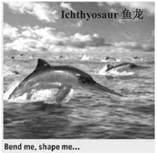
If a diver surfaces too quickly, he may suffer the bends. Nitrogen (氮) dissolved (溶解) in his blood is suddenly liberated by the reduction of pressure. The consequence, if the bubbles (气泡) accumulate in a joint, is sharp pain and a bent body—thus the name. If the bubbles form in his lungs or his brain, the consequence can be death.
Other air-breathing animals also suffer this decompression (减压) sickness if they surface too fast: whales, for example. And so, long ago, did ichthyosaurs. That these ancient sea animals got the bends can be seen from their bones. If bubbles of nitrogen form inside the bone they can cut off its blood supply. This kills the cells in the bone, and consequently weakens it, sometimes to the point of collapse. Fossil (化石) bones that have caved in on themselves are thus a sign that the animal once had the bends.
Bruce Rothschild of the University of Kansas knew all this when he began a study of ichthyosaur bones to find out how widespread the problem was in the past. What he particularly wanted to investigate was how ichthyosaurs adapted to the problem of decompression over the 150 million years. To this end, he and his colleagues traveled the world’s natural-history museums, looking at hundreds of ichthyosaurs from the Triassic period and from the later Jurassic and Cretaceous periods.
When he started, he assumed that signs of the bends would be rarer in younger fossils, reflecting their gradual evolution of measures to deal with decompression. Instead, he was astonished to discover the opposite. More than 15% of Jurassic and Cretaceous ichthyosaurs had suffered the bends before they died, but not a single Triassic specimen (标本) showed evidence of that sort of injury.
If ichthyosaurs did evolve an anti-decompression means, they clearly did so quickly—and, most strangely, they lost it afterwards. But that is not what Dr Rothschild thinks happened. He suspects it was evolution in other animals that caused the change.
Whales that suffer the bends often do so because they have surfaced to escape a predator (捕食动物) such as a large shark. One of the features of Jurassic oceans was an abundance of large sharks and crocodiles, both of which were fond of ichthyosaur lunches. Triassic oceans, by contrast, were mercifully shark- and crocodile-free. In the Triassic, then, ichthyosaurs were top of the food chain. In the Jurassic and Cretaceous, they were prey (猎物) as well as predator—and often had to make a speedy exit as a result.
小题1:Which of the following is a typical symptom of the bends?
A.A twisted body.
B.A gradual decrease in blood supply.
C.A sudden release of nitrogen in blood.
D.A drop in blood pressure.小题2:The purpose of Rothschild’s study is to see ______.
A.how often ichthyosaurs caught the bends
B.how ichthyosaurs adapted to decompression
C.why ichthyosaurs bent their bodies
D.when ichthyosaurs broke their bones小题3:Rothschild’s finding stated in Paragraph 4 ______.
A.confirmed his assumption
B.speeded up his research process
C.disagreed with his assumption
D.changed his research objectives小题4:Rothschild might have concluded that ichthyosaurs ______.
A.failed to evolve an anti-decompression means
B.gradually developed measures against the bends
C.died out because of large sharks and crocodiles
D.evolved an anti-decompression means but soon lost it

